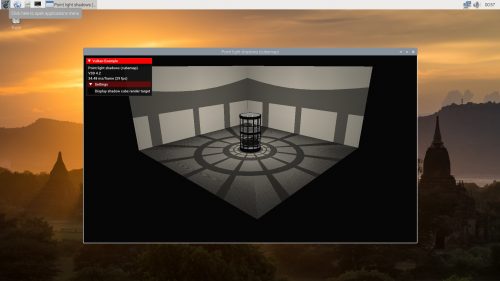Today we have a guest post from Igalia’s Iago Toral, who has spent the past year working on the Mesa graphic driver stack for Raspberry Pi 4.
It is almost five months since we announced the Vulkan effort for Raspberry Pi 4. It was great to see how many people were excited about this, and today we would like to give you a status update on our progress over these last months.
When we announced the effort back in January we were at the point of rendering a coloured triangle, which required only minimal coverage of the Vulkan 1.0 API in the driver. Today, we are passing over 70,000 tests from the Khronos Conformance Test Suite for Vulkan 1.0 and we have an implementation for a significant subset of the Vulkan 1.0 API.
Progress so far, in pictures
While I could detail here all the features that we have implemented, I am sure that list would get long and boring very quickly for most of you. So, instead, we would like to show you our progress through pics taken from a bunch of the popular Vulkan demos by Sascha Willems running on Raspberry Pi 4:
Hopefully that is more entertaining than a feature checklist and will help you visualize better where we are now compared to January’s coloured triangle.
Before you get too excited though, while these demos are nice, they are still a far cry from actual games and applications. We still have a lot of work to do before the driver can handle these more complex workloads. Even some of Sascha’s demos don’t run yet, whether because of driver bugs or unimplemented Vulkan features. We still have a lot of work ahead of us.
Next up
I would also like to give you an overview of some of the things we will be working on in the coming months:
Our first priority is to support the basic Vulkan 1.0 feature set. This will involve, at least, supporting compute shaders, input attachments, texel buffers, storage images, pipeline caches, and multisampling. There are some other features that we need to support in Vulkan 1.0, such as robust buffer access etc, but those are probably the largest ones we are currently missing.
Once we are feature-complete we will probably move focus to CTS conformance, which will be all about bugfixing, and making sure we handle spec corner cases. And once we are close to conformance, the driver should hopefully be stable and robust enough that we should probably start testing actual Vulkan applications and games to drive further bugfixing work.
Finally, there will be a lot of performance tuning and optimization work that we will probably tackle in the last stages of development.
So as I said before, we still have a long way to go!
Moving development to an open repository
Before we end this post, I would also like to share another important piece of news: starting today, we are moving development of the driver to an open repository. You can find instructions on how to build and install the driver here. I know this is something that many of you have been asking for, and I am sorry that it took us a few months to get here. But I think that now that we have a more stable driver infrastructure in place, and we don’t feel like we are constantly making large changes every other day, development should be a lot friendlier to external contributors than it may have been a few months ago.
So that’s everything we wanted to share today – I hope you are still excited about Vulkan and looking forward to future updates. In the meantime, if you have questions or are interested in contributing to the driver, join us on irc.freenode.net, #videocore channel.
Website: LINK





